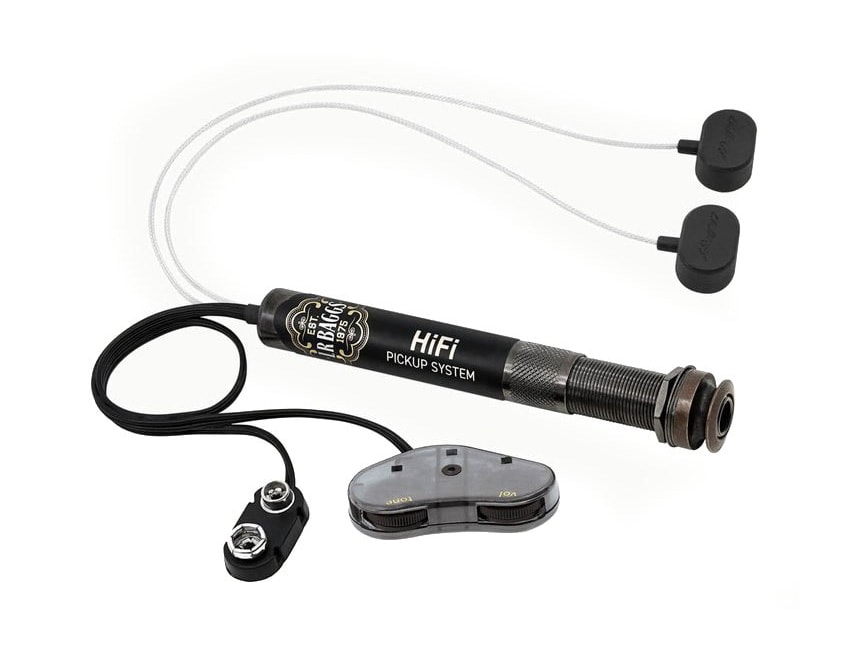Rabbit Holes and Acoustic Pickups

What do rabbit holes and acoustic pickups have in common? Well, nothing really, but if you use the term in the Lewis Carroll manner (Alice in Wonderland), acoustic pickups are a group of products you can quickly become disoriented or lost in. I’m going to do my best to keep my jaded old opinions out of this blog, because truly, which acoustic pickup you use is really a personal choice.
So back in the 1920’s when the Loyd Loar archtop (which Gibson anointed with the L5 moniker) replaced the banjo in a lot of jazz type bands, the quest for added volume began. Loyd left Gibson in the early 30’s and started the Vivitone company which developed a unique pickup for acoustic guitars. This opened the flood gates…Harry DeArmond started designing pickups, as did companies like Gibson and Rickenbacker. By the 50’s even Martin jumped into the fray. All these companies had varying but rather insignificant success with the acoustic pickups, but the design process in some ways mirrored and promoted the electric guitar pickup surge. Many performers however, were happy to just stick a decent mic in front of their acoustic and deal with the sound-engineers’ headaches.
Then….in the early 70’s, a performer every guitar player should be aware of (Glen Campbell) requested from the company he endorsed (which was Ovation Guitars) an electric-acoustic. The company placed a piezo pickup on one of its trademark (round-back) guitars. The piezo sat under the bridge saddle and used crystals to produce electric signals when hit with the guitar’s vibrations. They also placed the volume knob on the side of the guitar so the top could vibrate more freely and would not look unsightly. With this new guitar Campbell was free to walk anywhere on stage that the cable would allow, and to solo onstage with full control of the guitar’s volume. This guitar started the piezo revolution in acoustic guitar pickups, one which continues to this day. Takamine took up the challenge quickly in the late 70’s and placed 6 piezo crystals under the bridge saddle to maximize the clarity between strings. This again revolutionized the electro-acoustic and it was rumored that players were buying Takamine’s so they could tear them apart and steal the electronics.
As popular as the piezo’s were, there were players who said they sounded artificial, and maintained they didn’t capture the sound of the guitar top (which is responsible for 75% of the guitar sound). Barcus Barry designed a sound-board transducer which was easily fixed to and removed from the guitar’s top. This pickup, they promised, would recreate a truer sound from the soundboard. Neil Young used a similar device known as a FRAP that allegedly captured the vibrations of a soundboard in all directions. In the 80’s, Sunrise became famous for their magnetic soundhole pickup, but of course that was not a new design. DeArmond created soundhole pickups decades before, and many companies like Kent Armstrong, Dimarzio, Bill Lawrence etc all had soundhole models to compete in the market. Toward the end of the 80’s the first flexible soundhole mic was created by Ken Donnell, which introduced the next massive change in acoustic pickups. Since that time, not really a lot has changed….the competition switched it’s focus to pre-amps and the amount of flexibility they offered. Combination or hybrid setups that used 2 or 3 of the previously mentioned pickup technologies have also become quite common in another way to increase what each guitar is capable of. Of course there have also been guitars like the Line 6 Variax, which use the guitar strings as triggers for the digital samples the guitar has on-board….allowing an acoustic looking guitar to sound like many different instruments.
Today, when you check through the Solo website, you have several choices available. Your first decision is why you want to amplify your acoustic. Are you a performer? Will you be a performer? Is it just an experiment? It is a big question, and your acoustic (whether it be a Solo Kit, or a hand-made custom guitar) should be the prime consideration. A lot depends on your style of playing…are you an instrumentalist, are you percussive like Kaki King, do you use effects like Monte Montgomery, or are you a purist wanting only to hear the love and knowledge the builder put in creating this instrument. Personally, if I spend $5000 – $10,000 on a guitar, there will be no pickup built in of any kind (yeah sorry, this is an opinion lol). If I want a performance guitar, I will buy something or build something road-worthy and install what I consider the best pickup system. I am not opposed to using a sound-hole pickup either, in fact still have my Bill Lawrence Sound Hole Pickup I purchased about 50 years ago.
My best advice while looking through our selection here at Solo, is to do your homework. Decide what you want from this pickup, and whether you want to cut a gaping hole in the side of your guitar for the preamp, or whether you want to go with a stick-on transducer or microphone. In my experience, all these acoustic pickups have their own qualities and flexibilities. Once you have decided on a style of acoustic pickup, you get to choose from our full selection of brands, whether it be Dimarzio, Fishman, Fender, Lace, Schaller, Seymour Duncan or LR Baggs, I am sure you will achieve the sound quality you are looking for. If you need some help, our sales reps are well versed in the products and can help you choose….or even install the pickup for you. Yup…all right here at Solo Guitars!!! Let me know if you want to get deeper into the rabbit hole, and we can discuss the various attributes of one style compared to another….


